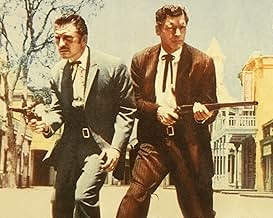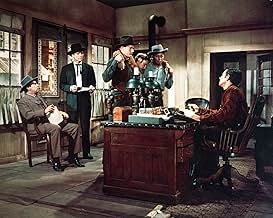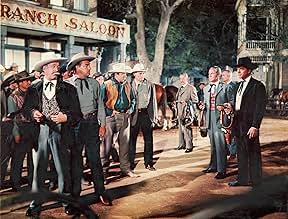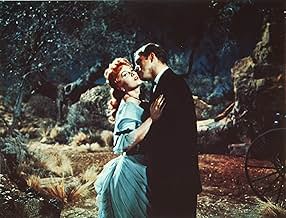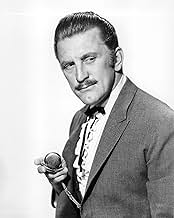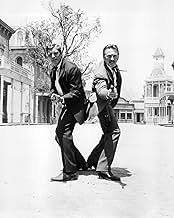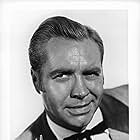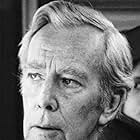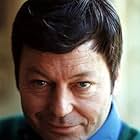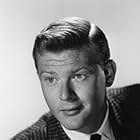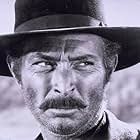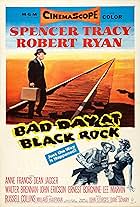Lawman Wyatt Earp and outlaw Doc Holliday form an unlikely alliance which culminates in their participation in the legendary Gunfight at the O.K. Corral.Lawman Wyatt Earp and outlaw Doc Holliday form an unlikely alliance which culminates in their participation in the legendary Gunfight at the O.K. Corral.Lawman Wyatt Earp and outlaw Doc Holliday form an unlikely alliance which culminates in their participation in the legendary Gunfight at the O.K. Corral.
- Nominated for 2 Oscars
- 3 wins & 4 nominations total
Ted de Corsia
- Shanghai Pierce
- (as Ted DeCorsia)
- Director
- Writers
- All cast & crew
- Production, box office & more at IMDbPro
Storyline
Did you know
- TriviaThe legendary gunfight took place on October 26, 1881 and lasted thirty seconds, resulting in three dead men after an exchange of thirty-four bullets. The fictionalized gunfight in this movie took four days to film, and produced an on-screen bloodbath that lasted five minutes.
- GoofsWyatt and Cotton reminisce about Oklahoma City, which was not founded until 1889.
- Quotes
Wyatt Earp: All gunfighters are lonely. They live in fear. They die without a dime, a woman or a friend.
- ConnectionsFeatured in Entertainment This Week Salutes Paramount's 75th Anniversary (1987)
- SoundtracksGunfight at the O.K. Corral
(1957)
by Ned Washington and Dimitri Tiomkin
Sung by Frankie Laine
A Columbia Recording Artist
Featured review
One of Hollywood's major offerings of 1957, "Gunfight" contains all the ingredients one would expect of a blockbuster - big stars, big budget and a storyline calculated to capture the public's imagination. For me, however, the film doesn't quite work. In the final analysis, the whole thing is a little too sluggish, a little too formulaic.
To be sure, it contains fine things. Burt Lancaster is stolid and unyielding as hard lawman Wyatt Earp. Sturges films him with the camera at ground level as he rides onto the screen, making him seem superhuman in his larger-than-life moral certainty. He faces down the armed drunk without the faintest twitch of fear, the embodiment of a strong, righteous enforcer of the law. The friendship between the paragon and the wastrel is cleverly done, with Earp and Holliday (Kirk Douglas) each seeing something to admire in the other, very different, man. Character is also to the fore as a plot-driver when Kate Fisher (Jo Van Fleet) is forced by the dynamics of her relationship with the Doc into ever more wretched behaviour. By comparison, the Earp-Laura love story is cold and staid. Both Lancaster and Rhonda Fleming are terrific to look at, but hard to warm to. Though the film takes an eternity to get to the shoot-out which is its raison d'etre, when the climax finally comes the suspense is built superbly. In a nice symmetry, we see the women of both sides dreading the fatal clash as Ma Clanton and Virgil's wife separately mourn the departure of their respective menfolk. Douglas made a career out of playing generous-spirited bad guys, and one of the best things in this film is Doc Holliday's heroic effort of will, rising from his sickbed to stand beside his friend in the face of mortal danger. Shot in a rich Technicolor palette, the film's images are strong and clean, and at times even beautiful, for example the barn fire, or the approach of the Earp faction, with Cotton standing facing them, his body framed by the corral building.
Other elements are not so well done. Wyatt is too unrelenting a hard man to win the audience's unqualified sympathy, as in the scene when he tells the all-too-human Cotton, "If you can't handle it any more, turn in your badge." The Frankie Laine ballad, almost de rigeur in 1950's westerns, is simply not up to scratch ("Boot Hill, Boot Hill, so cold, so still ...") There is an ugly shadow eclipsing Ike Clanton's face throughout his most important scene. Billy (a very young Dennis Hopper) is 'converted' by Wyatt far too easily.
There exists a wide spectrum of opinion on the question of how loyal a work of fiction should remain to the historical event which inspired it. One camp would argue that the artist has total freedom to rework a popular legend such as The Gunfight, while the other extremity would insist on documentary accuracy. This film is interesting, in that it takes a well-known incident for which contemporaneous records abound, and virtually disregards the historical truth.
In the film, the decent, clean-shaven Earp boys are merely 'doing what a man has to do'. We know that the Clanton-McLaury gang is mean and duplicitous, and that there will have to be a showdown between Right and Wrong. The shoot-out, when it comes, happens over several minutes of time on a clear, bright day. There is an athletic battle of movement, with the Earps in particular manoeuvring for position, and finally trapping the Clantons in and around a burning wagon. The strategic intentions of the good guys are clear and easy to follow.
The reality of October 26, 1881 was quite different. Two gangs of walrus-mustachioed men confronted each other, standing face-to-face in a built-up street. The shooting lasted a maximum of 30 seconds, and when the smoke cleared, three of the so-called "cowboy faction" lay dead or mortally wounded, whereas the Earp faction sustained only minor wounds. Wyatt was totally unharmed. Ike Clanton and Billy Claiborne, two of the cowboy leaders, had in fact run away when the guns opened fire.
This was no tussle between Good and Evil. Wyatt Earp was not a US Marshall, as the film tries to insist. He was Virgil's assistant with purely local authority, little more than his brother's pinch-hitter. Doc Holliday held no office of any kind. This was a clash between two Americas - the Earps representing the urban, northern, republican culture which had won the Civil War, while the Clantons stood for the freebooting, democratic, open-range mentality whose sympathies lay with the vanquished South.
A motion picture has a span of something like 90 minutes in which to set out its stall. Perhaps such a narrow intellectual space imposes so many constrictions that the true flavour of a historic event can never be properly represented. Or maybe the limitations of the medium set the film-maker free to create a better, more poetic "reality". I don't know the answer. There probably isn't one.
To be sure, it contains fine things. Burt Lancaster is stolid and unyielding as hard lawman Wyatt Earp. Sturges films him with the camera at ground level as he rides onto the screen, making him seem superhuman in his larger-than-life moral certainty. He faces down the armed drunk without the faintest twitch of fear, the embodiment of a strong, righteous enforcer of the law. The friendship between the paragon and the wastrel is cleverly done, with Earp and Holliday (Kirk Douglas) each seeing something to admire in the other, very different, man. Character is also to the fore as a plot-driver when Kate Fisher (Jo Van Fleet) is forced by the dynamics of her relationship with the Doc into ever more wretched behaviour. By comparison, the Earp-Laura love story is cold and staid. Both Lancaster and Rhonda Fleming are terrific to look at, but hard to warm to. Though the film takes an eternity to get to the shoot-out which is its raison d'etre, when the climax finally comes the suspense is built superbly. In a nice symmetry, we see the women of both sides dreading the fatal clash as Ma Clanton and Virgil's wife separately mourn the departure of their respective menfolk. Douglas made a career out of playing generous-spirited bad guys, and one of the best things in this film is Doc Holliday's heroic effort of will, rising from his sickbed to stand beside his friend in the face of mortal danger. Shot in a rich Technicolor palette, the film's images are strong and clean, and at times even beautiful, for example the barn fire, or the approach of the Earp faction, with Cotton standing facing them, his body framed by the corral building.
Other elements are not so well done. Wyatt is too unrelenting a hard man to win the audience's unqualified sympathy, as in the scene when he tells the all-too-human Cotton, "If you can't handle it any more, turn in your badge." The Frankie Laine ballad, almost de rigeur in 1950's westerns, is simply not up to scratch ("Boot Hill, Boot Hill, so cold, so still ...") There is an ugly shadow eclipsing Ike Clanton's face throughout his most important scene. Billy (a very young Dennis Hopper) is 'converted' by Wyatt far too easily.
There exists a wide spectrum of opinion on the question of how loyal a work of fiction should remain to the historical event which inspired it. One camp would argue that the artist has total freedom to rework a popular legend such as The Gunfight, while the other extremity would insist on documentary accuracy. This film is interesting, in that it takes a well-known incident for which contemporaneous records abound, and virtually disregards the historical truth.
In the film, the decent, clean-shaven Earp boys are merely 'doing what a man has to do'. We know that the Clanton-McLaury gang is mean and duplicitous, and that there will have to be a showdown between Right and Wrong. The shoot-out, when it comes, happens over several minutes of time on a clear, bright day. There is an athletic battle of movement, with the Earps in particular manoeuvring for position, and finally trapping the Clantons in and around a burning wagon. The strategic intentions of the good guys are clear and easy to follow.
The reality of October 26, 1881 was quite different. Two gangs of walrus-mustachioed men confronted each other, standing face-to-face in a built-up street. The shooting lasted a maximum of 30 seconds, and when the smoke cleared, three of the so-called "cowboy faction" lay dead or mortally wounded, whereas the Earp faction sustained only minor wounds. Wyatt was totally unharmed. Ike Clanton and Billy Claiborne, two of the cowboy leaders, had in fact run away when the guns opened fire.
This was no tussle between Good and Evil. Wyatt Earp was not a US Marshall, as the film tries to insist. He was Virgil's assistant with purely local authority, little more than his brother's pinch-hitter. Doc Holliday held no office of any kind. This was a clash between two Americas - the Earps representing the urban, northern, republican culture which had won the Civil War, while the Clantons stood for the freebooting, democratic, open-range mentality whose sympathies lay with the vanquished South.
A motion picture has a span of something like 90 minutes in which to set out its stall. Perhaps such a narrow intellectual space imposes so many constrictions that the true flavour of a historic event can never be properly represented. Or maybe the limitations of the medium set the film-maker free to create a better, more poetic "reality". I don't know the answer. There probably isn't one.
- How long is Gunfight at the O.K. Corral?Powered by Alexa
Details
- Release date
- Country of origin
- Language
- Also known as
- Duelo de titanes
- Filming locations
- Old Tucson - 201 S. Kinney Road, Tucson, Arizona, USA(Tombstone in the opening scene is the same bridge and town as "Rio Bravo" w/John Wayne and was filmed in "Old Tucson".)
- Production company
- See more company credits at IMDbPro
Box office
- Budget
- $2,000,000 (estimated)
- Runtime2 hours 2 minutes
- Color
- Aspect ratio
- 1.85 : 1
Contribute to this page
Suggest an edit or add missing content

Top Gap
By what name was Gunfight at the O.K. Corral (1957) officially released in India in English?
Answer

